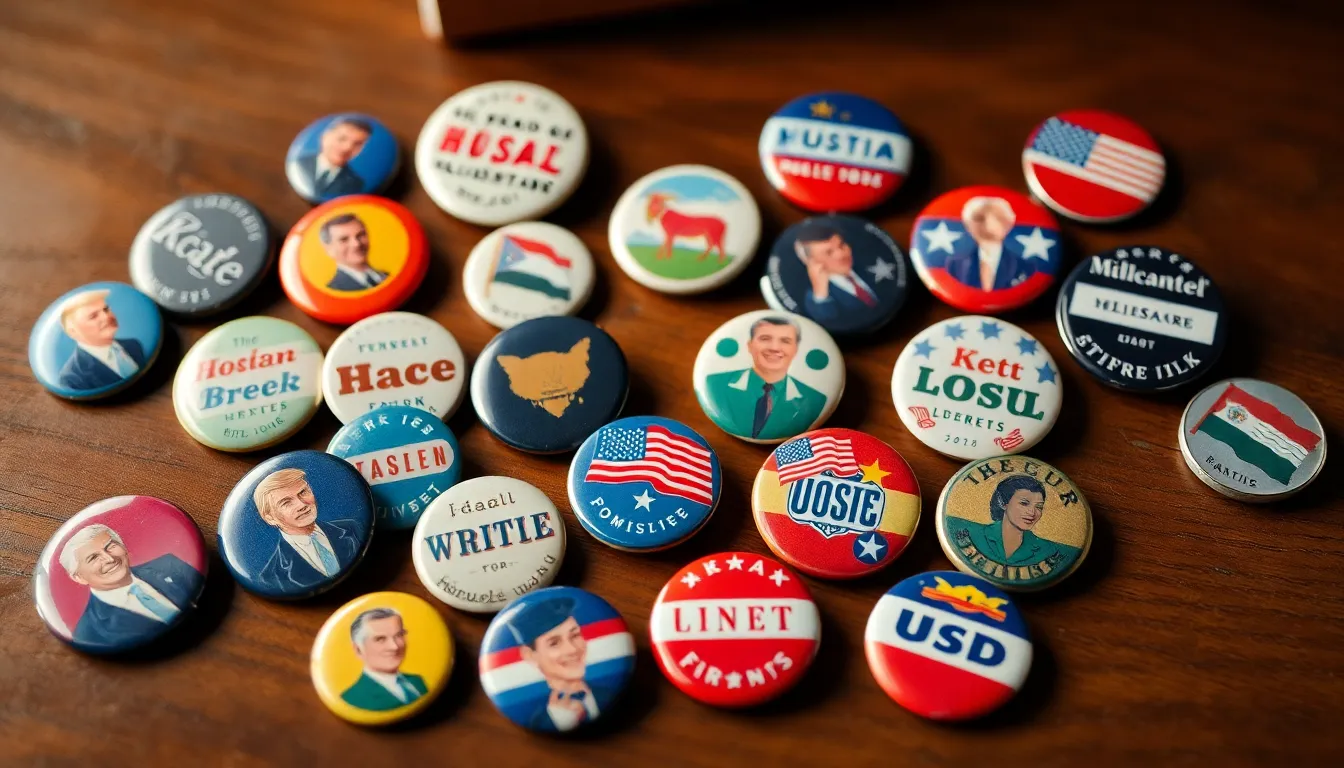Table of Contents
TogglePolitical pins have become the quirky little stars of campaign trails and rallies alike. These tiny badges pack a punch, showcasing everything from witty slogans to bold endorsements. With a flicker of color and a dash of humor, they turn ordinary citizens into walking billboards, all while sparking conversations that could rival any political debate.
Wearing a political pin isn’t just about fashion; it’s a statement. It’s like saying, “I’m not just here for the free snacks—I’ve got opinions!” Whether it’s a vintage button from a bygone era or a modern take on today’s hottest issues, these pins add a playful twist to the serious business of politics. So, let’s dive into the world of political pins and discover why they’re more than just accessories—they’re conversation starters, icebreakers, and sometimes, the best way to show off a sense of humor in a heated discussion.
What Are Political Pins?
Political pins are small badges that carry significant meaning in the political arena. They convey messages through witty slogans and endorsements related to campaigns or candidates. Wearers often display these pins proudly, transforming themselves into walking advertisements for their preferred political figures.
These accessories serve as more than just fashion statements; they also generate conversations among individuals. During rallies and campaign events, political pins become tools for sparking discussions about various issues, creating a connection among people who share similar beliefs.
Particularly popular during election seasons, political pins reflect the sentiments of both supporters and opponents. Some may feature symbols reflecting party affiliation, while others highlight specific political issues. Collectors often seek out rare pins that represent pivotal moments in political history.
Design and branding play a crucial role in the effectiveness of political pins. Eye-catching designs attract attention, prompting questions and conversations. Successful pins often encapsulate the essence of a campaign, making them memorable and impactful.
In addition to their communicative function, political pins also foster a sense of community. Individuals wearing similar pins often bond over shared values, reinforcing their political identity. The collective display of pins at events encourages camaraderie among supporters.
Political pins are dynamic tools that merge fashion with political expression, enriching the discourse around campaigns and candidates. Their role extends beyond mere decoration, as they influence interactions in both informal and formal settings.
History of Political Pins

Political pins date back to the early days of American democracy, serving as tools for candidates to engage voters. These badges became particularly prominent during the 19th century, with campaigns utilizing them to represent party affiliation and political ideals.
Early Use in Campaigns
Initially, political buttons appeared in the United States in the 1890s. Campaigns often distributed these pins to garner support and fuel enthusiasm. Each pin featured the candidate’s name or party symbol, making it easy for voters to identify their preferences. George Washington’s campaign in 1789 foreshadowed this practice, as supporters wore ribbons and badges to signify loyalty. As elections progressed, political pins evolved, incorporating catchy phrases and images that sparked conversations. Candidates and their supporters embraced these badges, transforming wearers into prominent advocates for their policies.
Cultural Significance
Political pins carry deep cultural significance, often reflecting broader societal movements. They serve as visual representations of beliefs and values, uniting individuals around common causes. The Civil Rights Movement saw pins promoting equality and justice, galvanizing support for important reforms. Additionally, pins signal identity, allowing supporters to connect with others who share similar political views. This sense of belonging fosters community and solidarity during campaigns. Designers often incorporate cultural symbols into pin designs, enhancing their resonance with various voter demographics. Political pins continue to be vital in shaping political dialogue, illustrating the fusion of activism and visual communication.
Types of Political Pins
Political pins come in various styles, each serving different purposes. These small badges enhance political discourse, encourage dialogue, and promote causes.
Campaign Buttons
Campaign buttons represent candidates during elections. These buttons display candidate names, slogans, and images, promoting recognition and support. A large percentage of campaign buttons feature catchy phrases that resonate with voters. As affordable items, they easily circulate among supporters at rallies and events. Notably, these buttons play a crucial role in shaping public perception. Their colorful designs and bold messaging attract attention, making political statements visible.
Advocacy Pins
Advocacy pins focus on specific social issues or causes. These pins rally support for movements, such as women’s rights or environmental protection. Wearing an advocacy pin symbolizes commitment, encouraging discussions around pressing topics. Activists often utilize these pins to unite supporters and spread awareness. Many advocacy pins carry powerful messages that inspire action and promote change. Collectors often seek unique designs that reflect significant milestones in social justice movements.
Commemorative Pins
Commemorative pins celebrate historical events or influential leaders. These pins honor milestones like anniversaries or significant achievements in political history. They often feature emblematic designs and tell stories of triumph. Collectors value commemorative pins for their historical insights and artistic appeal. Specific designs may include the likeness of political figures or key symbols relevant to specific events. Commemorative pins serve as reminders of progress while connecting generations of supporters to their political heritage.
How to Collect Political Pins
Collecting political pins involves passion for history and engagement in political discourse. The process can provide insights into past campaigns and movements.
Tips for New Collectors
Start by researching the history of political pins to understand their significance. Attend political events or rallies, where pins are often distributed. Explore online marketplaces and local antique shops for hidden gems. Joining collector groups can provide valuable tips and networking opportunities. Focus on specific themes or eras to build a targeted collection. Document each pin with details about its history to enhance personal engagement.
Caring for Your Collection
Store pins in a cool, dry place to prevent damage from humidity and light. Use acid-free materials for display and storage, keeping them in pristine condition. Cleaning pins should involve gentle methods, avoiding harsh chemicals or abrasive materials. Regularly inspect the collection for signs of wear or deterioration, addressing any issues promptly. Handle pins with clean hands or gloves to preserve their surfaces. Organizing pins in labeled containers or albums can simplify viewing and enhance protection.
Political pins stand as powerful symbols of expression and connection within the political landscape. They not only serve as eye-catching accessories but also spark vital conversations about pressing issues and candidates. As collectors cherish these artifacts, they preserve a rich history that reflects societal movements and political milestones.
The evolution of political pins from simple badges to intricate designs highlights their importance in modern campaigns. For those looking to engage with political history or express their beliefs, political pins offer a unique blend of fashion and activism. Embracing these small yet impactful items can foster community and solidarity among individuals who share similar values.




